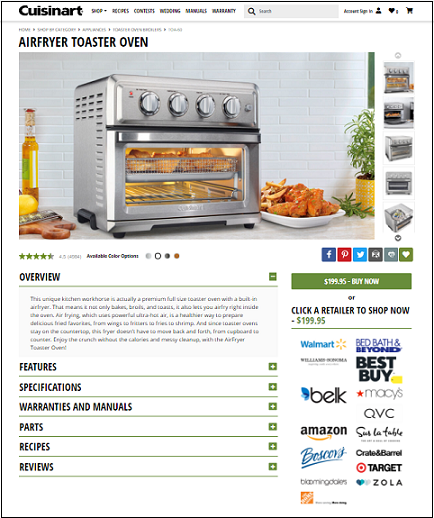Kitchen appliances, cookware and utensils brand Cuisinart is taking a plunge into selling directly to consumers online, but doing so in a way that doesn’t cut retailers out of the loop when shoppers visit its website.

Consumers can buy this air fryer toaster oven online directly from Cuisinart or one of several retailers.
The revamped ecommerce site, launched in June, sells a select variety of about 200 products, plus roughly 1,500 replacement parts and accessories. The objectives include boosting sales, learning more about customers and driving consumer engagement with the brand, says Mary Rodgers, director of marketing at Cuisinart. The site also offers opportunities for consumers to buy from retailers that sell online to consumers who shop there.
Shoppers can choose to buy items directly from Cuisinart or retailers with the same products listed on their websites. For example, consumers who want to buy Cuisinart’s air fryer toaster oven have the option of buying it from the manufacturer or one of 15 retailers, including Amazon.com Inc. (No. 1 in the 2020 Digital Commerce 360 Top 1000), Walmart Inc. (No. 3), Home Depot Inc. (No. 5), Best Buy Co. Inc. (No. 10) and Target Corp. (No 12).
The new website isn’t Cuisinart’s first try at selling to consumers, but it’s the brand’s first attempt to sell so many complete products online directly. Years ago, the manufacturer published a direct-mail catalog, which sold a limited selection of products. And for years, consumers could buy accessories and parts—such as replacements for broken carafes—directly from Cuisinart. For a time, Cuisinart outsourced the online sale of such items to an outside vendor.
“In late 2018, we decided as a corporation to start fulfilling our own orders,” Rodgers says. Cuisinart had recently opened a fulfillment center in Arizona. The brand built the facility to fulfill online orders made on retailer websites—which Cuisinart would then drop-ship directly to the consumers. Once that facility was available, Rodgers says, Cuisinart decided to use the facility for itself.
In 2019, Cuisinart started selling a limited selection of goods online. In January 2020, Cuisinart stated working with digital agency Whereoware. Over about six months, Whereoware built the new site and helped Cuisinart migrate to the Episerver’s Digital Experience Platform. Rodgers says the new website is “heavily data-driven” and includes more than a dozen complex integrations.
Besides adding promotional links to retailers that sell Cuisinart products, product detail pages on the new site include high-quality product imagery and video, in-depth product information, product reviews, and an improved “favorites” functionality for consumers, the manufacturer says. Cuisinart says extensive back-end data feeds generate the content for the product detail pages, saving Cuisinart’s team from doing manual updates of things like warranties, manuals, related parts, accessories ratings and retailer logos.
The new website and server also give Cuisinart control of its product data and search engine optimization (SEO) while allowing it to offer a mobile-friendly browsing experience for thousands of product SKUs, Rodgers says.
Rodgers says the new functionality means Cuisinart has more control than ever over the ways it presents its products online. “We’re owning our business now, rather than being reliant on… a different gatekeeper,” she says.
The improvements helped Cuisinart expand its online direct-to-consumer sales, which, for now, represent only 1% or less of the brand’s overall (online and offline) revenue, Rodgers says. “We don’t have a firm goal on percentage of total sales,” Rodgers says.
Cuisinart’s online, direct-to-consumer revenue for 2020 so far is up 103% compared with 2019, Rodgers says. “The growth is a combination of both organic and horizontal growth” attributable to digital marketing programs and expanding product offerings on the site over the past 12 months, she says. Organic sales are those generated as a direct result of existing operations. Horizontal growth refers to growth from geographic expansion and/or increasing the range of products and services offered.
For 2021, Cuisinart expects 14% year-over-year growth, not including added sales that might come from adding new products to the website.
Dealing with retailers is “a dance” for brand manufacturers, Rodgers says. And the costs of dealing with retailers has risen significantly in recent years as demands for co-op advertising dollars continue to increase, she says. “At some point, it can become unprofitable,” she says. Under co-op advertising arrangements, retailer wholesalers share the costs for locally placed advertising.
Building an online direct-to-consumer site gives Cuisinart a channel it can better control, but the brand doesn’t know what to expect, especially during a pandemic, Rodgers says.
“This is new territory; this is a new place we’re going to. Is there growth in front of us? Absolutely, there’s growth available. It just depends on what we decide to do and how much we decide to invest in it,” she says.